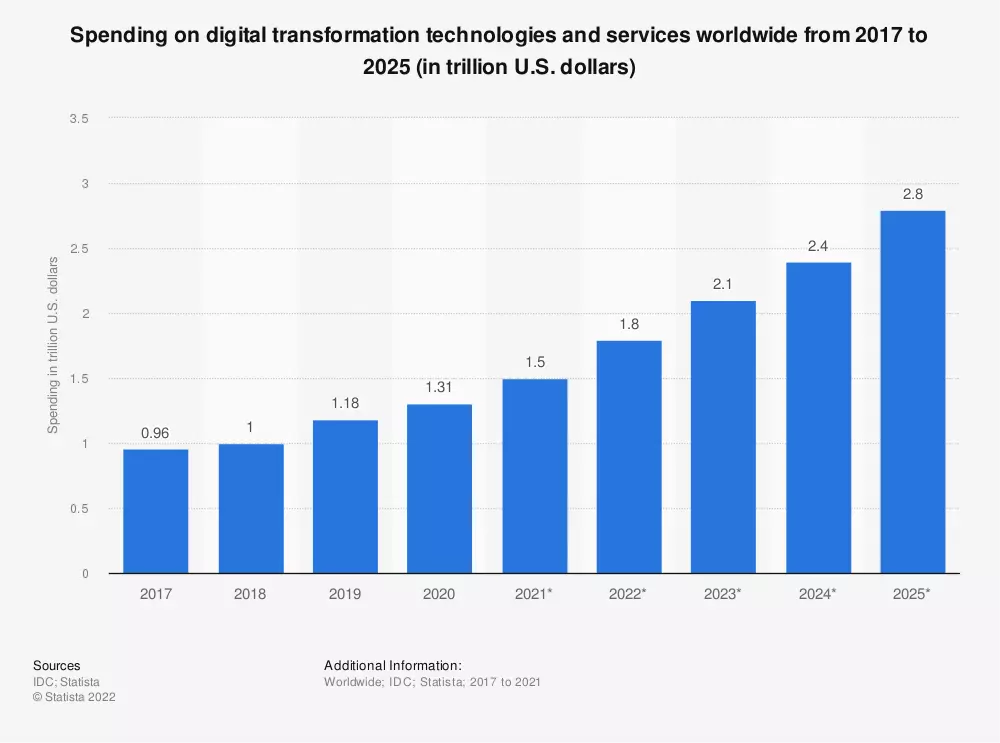The Manufacturing sector’s road to Digital Transformation
- Home
- Blog Details

- May 17 2022
- admin
For the last 20 years, the digital revolution has cast its shadow over every area of a well-functioning society, be it commerce, banking, or education and healthcare. The common thread throughout this digital revolution has been that those who do not embrace technology will eventually be left behind and replaced. It especially applies to manufacturers, who face the challenge of reducing costs and constantly keeping up with the global marketplace competition.
This article will define what Digital Transformation is, explore its implementation, and discuss the challenges it presents. Finally, we’ll look at the ideal Digital Transformation strategy. Taking advantage of new technology such as 5G can improve visibility, lower costs, and increase flexibility; the benefits of digital transformation in the manufacturing sector are significant. But how can companies get started?
Let’s look at some of the challenges and opportunities of digital transformation in manufacturing.
What does digital transformation mean?
In simple words, digital transformation is the large-scale exodus of the manufacturing sector and other domains from the traditional, analogue, manual mode of work toward digital technologies.
It isn’t just about putting a few computers onto the table. It is about embracing digital technology from top to bottom, end-to-end levels. Digital transformation is not related to physical conversion but also involves statistical analysis and data to enhance manufacturing processes to ensure a thriving business. The advent of digitalization in manufacturing can help companies become more flexible, responsive, and cost-efficient. By integrating modern tools into production, digital transformation helps companies manage inventory and costs. It can also improve service to customers. By incorporating digital tools into manufacturing processes, companies can enhance the quality of products and reduce non-productive time. Digital tools help companies stay on top of the latest trends in the industry, and they improve productivity.
It is important to remember that digital transformation is a process that takes years to complete. While the result may differ for each company, it will help to have a general idea of how to approach the process and plan accordingly. For example, the end goal should be “Point B” in the roadmap, while the next step is to fill in the gaps between where the company currently is and where it wants to be.
Caution!
A business that overlooks the importance of digital transformation is setting itself up for failure and providing their competitors an advantage in the market.
In a survey of manufacturing companies, it was found that 36% accelerated their digital transformation. A further 35% slowed their digital transformation, and 47% remained untouched. Of the companies that have undertaken digital transformation, only 30% plan to increase their investment in this process by 2022. As per a Statista survey, spending on digital transformation and services worldwide has grown exponentially from 2017 to 2025 (in trillion US dollars).

Implementation of Digital Transformation
Implementation of digital transformation in your company might seem a bit uphill task. However, there are four key areas where you can focus on implementing digital transformation successfully. They are as follows:
Boost your employees
Educate, Encourage, and Empower your employees. These are the three words you should focus on when introducing new technologies to your employees. It can be challenging if they are reluctant to adopt it. You need to give them some time and space to innovate as much as possible. Even if it is one step at a time, it is still worth consideration.
Interact with your Customers
Customers have a higher expectation of service speed and an enhanced experience. Utilize data and statistical analysis for better engagement with customers. It helps companies cater to the needs of their customers by offering the best possible experience. Track their interactions, choices, and frequent search history to understand their mindset. Enable customization to let customers play around with products and decide what they need.
Optimize the work processes
Optimize your processes and human resources. The old-school way of working leaves many redundancies and sections where the time lag is so remarkable that it can affect your entire business. The optimizing system leaves you relieved that your systems are sufficiently tuned to operate the business smoothly.
Transform the core of your business if necessary
It refers to changing the core of your business to keep up with technological advances. You must adapt to the changing market or be left behind with increasingly irrelevant products/services. If that requires modernization and introducing new technologies, so be it.
The Challenges with Digital Transformation
Despite technological advances, traditional manufacturing companies face increasing competition from newcomers who successfully apply new technologies to their businesses. You must overcome certain obstacles in digital transformation to gain a competitive advantage. These include:
Worker syndrome
One of the biggest challenges in implementing digital transformation is culture. As automation becomes more prevalent, many workers look down on the benefits of digitalization. In fact, the challenges with digitalizing the manufacturing sector are directly related to the workers themselves. Employee resistance to change and employee pushback may be due to their inexperience with the technology or fear that automation will take away their jobs.
Inadequate Information
A lack of information is a significant problem for many businesses. They don’t have the digital expertise necessary to understand what’s available or how it can be used, especially the workers. Unfortunately, errors in manufacturing are universal. Workers may set up machines incorrectly, mishandle equipment, or send sensitive data to an unknown email attachment. Moreover, workers will be left with an unavoidable culture of ‘that’s not how we do things.
Poor Strategy
The lack of a strategy is a significant hindrance for many businesses on their way to completing the digital transformation—a poorly planned strategy results in failures. For instance, a lack of clear path, funding, and legacy systems are just a few of the most common strategic obstacles. Therefore, almost 50% of manufacturers enlist the help of consultants to undertake digital transformation projects. Prescient Technologies has been a consultant to some top names worldwide who wanted to embrace digital transformation. Let us help you in your journey, click here, and let’s talk.
Money Matters
Budget is a common problem during a digital transition. Technology is an expensive investment and requires meticulous planning regarding financial supply & backup.
Framing an ideal Digital Transformation Strategy
The manufacturing sector is an industry that has lagged behind other industries regarding digital technology. The terms “industry 4.0” and the “industrial Internet of Things” have gained popularity in recent years, but many manufacturers are still far behind. This lack of digital innovation is frustrating, particularly for leaders looking to transform their companies. To be successful, you must have a well-laid digital transformation strategy. To make it happen, you’ll need to:
Get your employees onboard
Your road to a successful digital transformation will never be covered without having your employees on board. Employees form the backbone of your business, so it is critical to involve them throughout the entire conversion process. Get them excited about the possibilities of this transformation, get them hopeful about the perks it brings, and educate them about the lucrative opportunities.
Frame a great budget
Now that you have the buy-in from your stakeholders, it is time to examine your entire budget and decide how much you can afford to invest in digital transformation. You should be prepared to make significant monetary investments. Often, these initiatives are unaffordable for most manufacturers, but budgetary commitments will enable you to reap long-term benefits.
Examine your current digital readiness
Assess your ongoing digital state to determine where you stand on the broader picture. It would be best to plan accordingly about the journey ahead before you wonder about the outcome. Haphazard planning and overenthusiasm might lead to uncalled misfortune and losses.
Create a list of goals and milestones
Your digital transformation blueprint must be based on the company’s fundamental goals, identifying the most critical constraints and opportunities. Don’t leave out the subsections since these often- overlooked matters turn out to be crucial. Then, the company must set clear milestones and evaluate its progress. The goal should be to improve profitability, which can be accomplished by improving plant performance. Once the goals have been set, the implementation process can begin.
Mend the weaknesses and drawbacks
Knowing your weaknesses, limitations, and drawbacks is imperative to creating a better roadmap to digital transformation. Analyzing and fixing the existing defects will go a long way to ensure such issues never arise to hamper your business.
Create your roadmap
Lastly, the implementation process can begin once the goals have been set. Develop an excellent roadmap for your transformation. Create a flowchart that includes all the steps and clearly explains the roles and hierarchy to avoid any misunderstanding.
As technology evolves, manufacturers may not be as computer-savvy as they once were. A recent survey of manufacturing companies revealed that nearly half of them seek assistance from technology providers or consultants. The next most sought-after support comes from industry analysts. These new tools help manufacturers predict demand and ensure optimal production efficiency. And by increasing their ability to communicate with each other, manufacturers can keep prices competitive. A digitally transformed manufacturing organization can offer attractive customization options and attract skilled workers. The COVID-19 pandemic has not yet ended for manufacturers, but its impact on their supply chains has made digital technologies an essential part (a giant 68%) of the industry, and it is here to stay.
- adminhttps://www.pre-scient.com/author/webwideit/
- adminhttps://www.pre-scient.com/author/webwideit/
- adminhttps://www.pre-scient.com/author/webwideit/
- adminhttps://www.pre-scient.com/author/webwideit/

